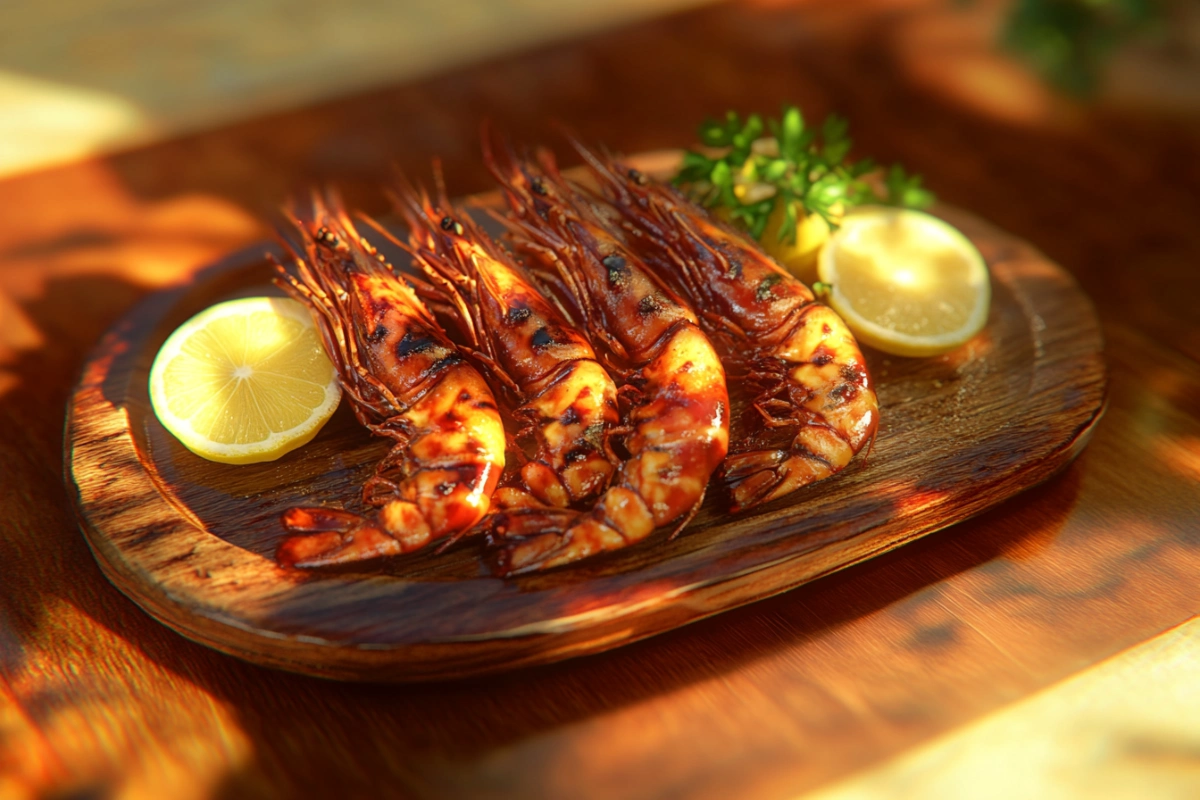Tiger shrimp, known for their striking appearance and impressive size, are a seafood lover’s dream. But how do they actually taste? This article dives deep into the world of tiger shrimp, exploring their unique flavor profile, cooking techniques, nutritional benefits, and how they stack up against other shrimp varieties. Whether you’re a culinary novice or a seasoned seafood connoisseur, this guide will help you master everything about these ocean delicacies. Let’s begin by understanding the basics of tiger shrimp.
Introduction to Tiger Shrimp
What Are Tiger Shrimp?
Tiger shrimp are a popular variety of shrimp, distinguished by their striped shells and larger-than-average size. Named after their tiger-like bands, these crustaceans are found in both warm coastal waters and aquaculture farms. They come in two main types: black tiger shrimp and white tiger shrimp, each offering subtle differences in flavor and appearance.
Their appeal goes beyond just their size. Tiger shrimp are favored for their firm texture, which holds up well in various cooking methods, and their versatility in global cuisines. They’re a staple in everything from stir-fries to grilled dishes, loved for their ability to soak up marinades and spices.
Key Characteristics of Tiger Shrimp
When it comes to flavor, tiger shrimp truly shine. They boast a mildly sweet taste with a savory finish, making them a favorite for seafood enthusiasts. The meat is succulent and tender, yet firm enough to offer a satisfying bite. Their natural sweetness intensifies when cooked, especially when grilled or sautéed.
Tiger shrimp are also visually stunning. Their striped shells, which range in color from bluish-gray to deep black, make them stand out in seafood markets. Once cooked, they turn a vibrant orange-red, adding a feast for the eyes to their delectable taste.
In summary, tiger shrimp are not only a visual and culinary delight but also a versatile ingredient that enhances any dish they’re featured in. Ready to explore their flavor in-depth? Let’s move on to part two, where we’ll uncover what makes their taste so unique.
The Flavor Profile of Tiger Shrimp
What Makes Tiger Shrimp Taste Unique?
Tiger shrimp are celebrated for their distinctive taste, which combines a mild sweetness with savory undertones. The flavor is more robust than smaller shrimp varieties, such as white or pink shrimp, making tiger shrimp a standout choice for those seeking a bolder seafood experience.
The slightly sweet taste of tiger shrimp intensifies when cooked, especially when grilled or sautéed with simple seasonings. For many, the answer to the question, “Do tiger shrimp taste good?” is a resounding yes! Their naturally delicious flavor means they don’t require heavy sauces or marinades to shine.
Moreover, the flavor can vary slightly depending on their source. Wild-caught tiger shrimp often have a deeper, more complex taste due to their natural diet, while farmed shrimp tend to have a milder profile.
Factors Influencing Taste
Several factors contribute to the unique taste of tiger shrimp. Freshness plays a critical role; like most seafood, the fresher the shrimp, the better the flavor. Cooking methods also make a significant difference. Overcooking can diminish their natural sweetness and leave the shrimp rubbery.
Lastly, their diet and habitat influence their taste. Wild-caught tiger shrimp, often caught in the Indian or Pacific Oceans, feed on a natural diet, resulting in a more pronounced flavor. In contrast, farmed shrimp, depending on their feed, may exhibit a slightly less pronounced taste.
For more details on preparing tiger shrimp to highlight their natural flavors, check out this guide on tiger shrimp preparation.
How to Cook Tiger Shrimp for Optimal Flavor
Popular Cooking Techniques for Tiger Shrimp
Tiger shrimp are versatile and can be cooked using various methods. Each technique brings out unique aspects of their flavor:
- Grilling: The high heat caramelizes the shrimp’s natural sugars, adding a smoky depth to their sweet and savory taste.
- Sautéing: A quick toss in a hot pan with garlic, butter, and herbs highlights their tender texture and bold flavor.
- Steaming: A gentler approach that preserves their natural sweetness and plump texture.
- Boiling: Perfect for shrimp cocktail, boiling keeps the shrimp firm yet tender and allows seasoning in the water to seep into the meat.
Each of these methods ensures that the shrimp remain the star of the dish.

Enhancing the Flavor of Tiger Shrimp
While tiger shrimp are delicious on their own, adding the right ingredients can elevate their taste. Simple marinades featuring lemon, garlic, and olive oil can enhance their natural sweetness. Spices like paprika, cayenne, or Old Bay seasoning create a delightful contrast to their mild flavor.
However, avoid overpowering sauces or excessively long cooking times, as these can mask their delicate taste. A simple rule of thumb is to cook them just until they turn pink and opaque. For recipe inspiration, explore why tiger shrimp dishes stand out.
When cooked thoughtfully, tiger shrimp offer a dining experience that’s both satisfying and memorable. Whether you’re a seafood enthusiast or trying them for the first time, tiger shrimp are bound to impress.
Nutritional Benefits and Culinary Uses
Nutritional Highlights of Tiger Shrimp
Tiger shrimp are not just delicious; they’re also a powerhouse of nutrients. Low in calories but high in protein, they’re an excellent choice for those seeking a healthy meal option. A 3-ounce serving provides around 20 grams of protein, contributing significantly to your daily intake. Plus, tiger shrimp are naturally low in fat and carbohydrates, making them ideal for low-carb and keto diets.
Additionally, tiger shrimp are packed with essential nutrients like selenium, zinc, and vitamin B12. Selenium, in particular, plays a key role in promoting heart health and strengthening the immune system. The omega-3 fatty acids in shrimp also contribute to brain and heart health, making them a smart choice for overall well-being.
If you’ve ever wondered, “Do tiger shrimp taste good while being healthy?” the answer is absolutely yes—they deliver flavor and nutrition in every bite.
Versatility in Recipes
Tiger shrimp are among the most versatile seafood ingredients you can find. Whether grilled, sautéed, or steamed, they pair beautifully with a range of ingredients and cuisines. For example, they’re a fantastic addition to pasta dishes, stir-fries, or salads. Want to keep it simple? Serve grilled tiger shrimp with a side of garlic butter or lemon wedges for a crowd-pleasing appetizer.
They also pair well with other seafood like scallops and lobster, adding a variety of textures and flavors to a dish. If you’re looking for more ideas, you might enjoy browsing these creative tiger shrimp recipes.
For more meal inspirations, explore the full range of seafood ideas on Medium Recipes.
Comparing Tiger Shrimp to Other Shrimp Varieties
Tiger Shrimp vs. Regular Shrimp: Key Differences
Tiger shrimp are often compared to other shrimp varieties, like white or pink shrimp. So, what sets them apart? For starters, tiger shrimp are much larger, with firm, meaty flesh that stands out in both texture and flavor. Their sweet, bold taste is more pronounced, making them a popular choice for recipes where shrimp need to be the star.
Visually, tiger shrimp are distinctive with their striped shells, while other shrimp varieties typically have more uniform coloring. When asking, “Do tiger shrimp taste good compared to regular shrimp?” it’s all about preference, but tiger shrimp are widely favored for their rich and robust flavor.
Why Choose Tiger Shrimp Over Others?
Choosing tiger shrimp often comes down to their versatility and ability to stand up to bolder flavors. While smaller shrimp may get lost in heavy sauces, tiger shrimp maintain their presence in dishes like curries, garlic butter shrimp, and seafood stews. Their larger size also makes them easier to prepare and serve, whether skewered for grilling or featured in pasta.
If you’re torn between tiger shrimp and other varieties, try experimenting with both to see which works best for your favorite dishes. For a deep dive into shrimp comparisons, read more at Medium Recipes.
Whether you’re planning a casual dinner or an elegant seafood spread, tiger shrimp are a versatile and flavorful choice that’s sure to impress!
FAQs on Tiger Shrimp Taste and Cooking
What Are Common Questions About Tiger Shrimp Taste?
Tiger shrimp often spark curiosity, especially among seafood enthusiasts and home cooks alike. Here are answers to some frequently asked questions:
- How does tiger shrimp taste compared to white shrimp?
Tiger shrimp have a bolder, sweeter flavor than white shrimp, which are typically milder. The firm texture of tiger shrimp also makes them stand out. - Are tiger shrimp sweeter than other shrimp varieties?
Yes, tiger shrimp are naturally sweeter, especially when cooked properly. Their taste is often described as rich and slightly briny. - What is the best way to prepare tiger shrimp for full flavor?
Grilling or sautéing with garlic and butter highlights their natural sweetness while preserving their texture. - Do tiger shrimp taste different when farmed vs. wild-caught?
Wild-caught tiger shrimp tend to have a stronger, more complex flavor because of their natural diet. Farmed shrimp are milder, but still delicious.
Tips for Cooking Tiger Shrimp Perfectly
Cooking tiger shrimp doesn’t have to be complicated. Follow these tips to get the best flavor and texture:
- Don’t overcook them. Shrimp cook quickly, usually in 3–4 minutes. Once they turn pink and opaque, they’re ready to eat.
- Use simple seasonings. Garlic, lemon, and a touch of olive oil or butter bring out their natural sweetness without overwhelming their taste.
- Try marinades. A quick marinade with citrus or soy sauce can enhance their flavor, but keep it light to let the shrimp shine.
If you’ve ever wondered, “Do tiger shrimp taste good when cooked with spices?” the answer is yes, as long as the seasoning complements their natural flavor.
Conclusion – Why Tiger Shrimp Are a Must-Try
Tiger shrimp offer a unique combination of bold flavor, satisfying texture, and visual appeal. Whether you’re grilling them for a summer barbecue, tossing them into pasta, or enjoying them as a standalone dish, they are sure to elevate any meal.
From their mild sweetness to their versatility in the kitchen, tiger shrimp are a seafood lover’s dream. And if you’re still asking, “Do tiger shrimp taste good?” the best way to find out is to try them for yourself. With the right preparation, these crustaceans deliver a taste experience that’s hard to beat.
Whether you’re a seasoned cook or just starting your seafood journey, tiger shrimp deserve a place on your menu. Ready to dive into their world? Start exploring recipes and cooking techniques to enjoy tiger shrimp at their best.
Why Tiger Shrimp Are Loved by Seafood Enthusiasts
The Unique Appeal of Tiger Shrimp
Tiger shrimp have earned their place as a favorite among seafood enthusiasts for good reason. Their distinctive flavor profile—a balance of mild sweetness and savory notes—sets them apart from other shrimp varieties. Additionally, their firm texture holds up beautifully in a variety of cooking methods, making them a versatile ingredient for both simple meals and gourmet dishes.
Their impressive size and striking striped shells make them a visually appealing choice, perfect for dinner parties or special occasions. For those still asking, “Do tiger shrimp taste good?” the resounding feedback from foodies is that they’re a top-tier seafood choice.
Nutritional Content (Per 100g)
Tiger shrimp aren’t just delicious—they’re also highly nutritious. Below is the nutritional breakdown per 100g serving of tiger shrimp:
| Nutrient | Amount | % Daily Value* |
|---|---|---|
| Calories | 85 kcal | 4% |
| Protein | 20 g | 40% |
| Fat | 0.5 g | 1% |
| Carbohydrates | 0 g | 0% |
| Selenium | 40 mcg | 73% |
| Vitamin B12 | 1.1 mcg | 18% |
| Omega-3 Fatty Acids | 0.3 g | — |
*Percent Daily Values are based on a 2,000-calorie diet.

Popular Dishes Featuring Tiger Shrimp
Tiger shrimp are the star of countless recipes worldwide. In Asian cuisine, they’re often stir-fried with garlic, ginger, and soy sauce, while Mediterranean dishes pair them with olive oil, lemon, and herbs. Some popular dishes include:
- Shrimp scampi: A classic pasta dish with garlic and butter that highlights their natural sweetness.
- Shrimp tacos: Grilled tiger shrimp with a zesty lime crema and fresh toppings.
- Seafood skewers: Perfect for grilling, combining shrimp with vegetables for a smoky, caramelized flavor.
Whether you’re preparing a casual weeknight dinner or a festive feast, tiger shrimp are a versatile choice that never fails to impress.
How to Source the Best Tiger Shrimp
Tips for Buying High-Quality Tiger Shrimp
When buying tiger shrimp, freshness is key to getting the best flavor and texture. Look for shrimp with firm, translucent shells and a mild, ocean-like scent. Avoid shrimp with strong odors or black spots on the shell, as these may indicate spoilage.
Frozen tiger shrimp are a great option when fresh isn’t available. They’re typically frozen shortly after being caught, preserving their flavor and nutrients. To ensure you’re getting the best quality, choose shrimp labeled “wild-caught” or “sustainably farmed.”
Storage and Preparation Tips
Proper storage is essential to maintain the quality of tiger shrimp. If fresh, store them in the coldest part of your fridge and use them within 1–2 days. Frozen shrimp should be thawed gently in the fridge overnight before cooking.
For those curious, “Do tiger shrimp taste good when frozen?” the answer is yes, as long as they’re thawed and cooked correctly. Freezing doesn’t significantly impact their flavor when handled properly.
By sourcing high-quality tiger shrimp and following these tips, you can enjoy their bold, delicious taste in every dish. Whether grilled, sautéed, or served in a flavorful stew, tiger shrimp are a seafood treasure worth savoring.

